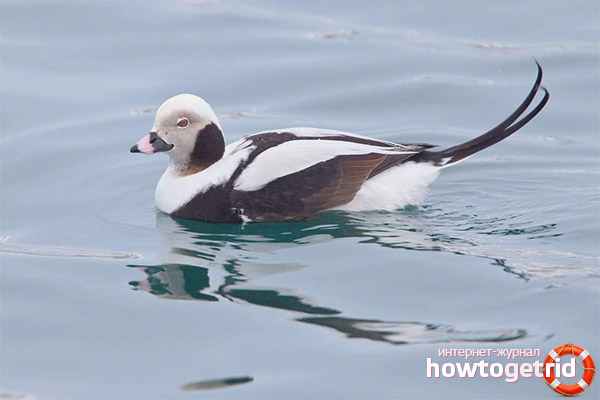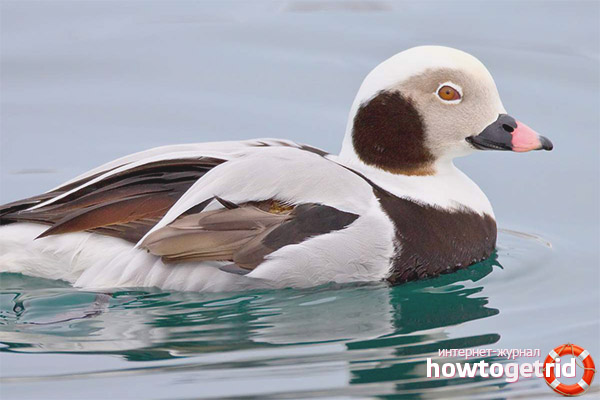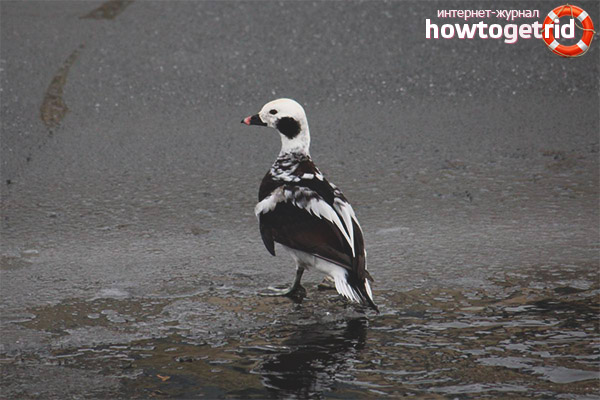The content of the article
Duck sailor - one of the most beautiful water birds that can be found in Central Europe. A distinctive feature of this bird is the possibility of diving under water, where it can be up to one minute. Thus, the mariner hunts for the food it needs to feed it - fish and shellfish. The immersion depth of this small-sized waterfowl can reach 50 meters.
The average flock sizes of these waterfowl read up to 100 individuals. Sailor flies low over the water, swaying slightly in the air.
Rising into the air, a sailor cannot raise its wings so that they reach a horizontal position, for this reason this restless and moving bird needs to be lowered deeper. When landing on the surface of the water, the sailor initially touches her breast, which distinguishes this duck from other subspecies that use paws for these purposes.
Peculiarities of feeding a sailor
In search of food suitable for food, the duck most often dives under water. The immersion depth of this waterfowl is quite large. Before a deep dive, the sailor makes a small jump up, with a sharp tilt of the head and the subsequent ejection of the hull forward and down. At the same time, the bird opens its wings.
To move under water, the sailor makes the characteristic raking movements of the wings. On the surface of the water, as a rule, birds of this species swim in a row, diving in turn for hunting. There are frequent cases when a flock, consisting of several dozens of sea-ewes, is immersed in water at the same time. In the cold season, the main food of the duck-sailor duck is crustaceans, mollusks, mussels, small crab and shrimp.
Also one of the delicacies of the seaman is starfish, small fish and small-bristle worms. In some cases, the marijuana can also feed on algae. The species of fish the duck hunts is Atlantic cod, gobies, and young flounders.
During the land nesting period, the main food of the duck-duck is various small insects, crustaceans living in freshwater reservoirs, and various plants.
Duck lifestyle
In mid-summer, molting of fly feathers begins. Often during this period of time, representatives of this species have a rather nondescript appearance. Note that it is during this period that molting birds do not have the ability to fly. The last molt occurs in early autumn, during which the drakes "dress up" in a more colorful and saturated with various shades of "autumn" outfit.
Frequent color and plumage changes give the duckling a sailor a lot more opportunities for camouflage while hunting. The mating attire of the male moyanka has a very bright and beautiful color, which, in fact, attracts females.
Propagation Features
The main nesting sites for the sea eater are the coastal zone of small reservoirs (coast of islands, the Arctic tundra, river deltas). The formation of a pair of birds occurs during the winter season. As a rule, in the place of the future nesting ducks of a sailor, fly in large flocks.
Females are engaged in the construction of nests independently, without the participation of drakes.To do this, a small hole is dug near the selected water source, which is lined with dry vegetation and down. Basically, after the nest is built, eggs appear in it within 7-10 days. The offspring of a sea eater hatch in the summer - June-August. The first days, little ducklings stay near the parent's nest, after which they descend into the water. Most of the chicks during the growing season die from attacks of more predatory bird species (skuas).
Characteristics of a duck
Ducks of a marine creature have a long tail and body, and the head is of medium size. On the water, the steering feathers of a sailor’s feather are raised high.
In the mating season, unlike the drake, the female has a more modest outfit. First of all, this is the absence of steering feathers. The female duck’s summer outfit looks more like a bright and attractive drake outfit.
Habitats of a Mariner
The main nesting sites of this waterfowl are the Arctic tundra, Scandinavia, the north of Russia, etc.
The total population of this duck is no less than about 10 million individuals, while about half a million ducks winter in Europe. Note that, although this duck is the most widespread on the earth, nevertheless, tens of thousands of sailors perish annually due to an unfavorable environmental situation (pollution of the sea with oil products).
Often, a duck can be found on the Moscow River (the mouth of Gorodnya), where it lives and feeds in reeds.
It should be noted that the mariner has a significant commercial value, especially in the tundra zone. It is this species of ducks that takes first place in terms of the number of prey. As a rule, the hunting season for this bird in the tundra begins in early spring. This is due to the fact that after the mariners migrate closer to the sea, poultry meat acquires a specific smell.
Interesting facts about the sailor

In North America, such a waterfowl as the duck of a morianka is commonly called “old squaw,” which literally means old or old Indian. This is due to the fact that this type of ducks makes characteristic sounds that are very reminiscent of the sounds made by old Native American women while singing their folk songs.
Sailor is a commercial bird, which has long been hunted in the north of Russia. It has very tasty and tender meat. Nevertheless, as mentioned above, early spring is chosen for hunting, since after the bird has gone to the sea, the duck meat acquires the smell of blubbering.
During the hatching period of offspring by females, drakes, as a rule, leave their nesting places. Often this is the coastal zone of water bodies. Such a “business trip” of males continues until the period of summer molting has passed, and they will not change their outfit to a more colorful “autumn” one.
Often, mariners leave their offspring even before the young ducklings learn to use their wings and rise into the air. This is due to the need to re-lay eggs.
Often in one nest, eggs are laid by two females. That is, the total number of eggs laid by ducks reaches 16-18 pieces.
Mariners are waterfowl, which, although they have a sufficient population, are nonetheless a species that is threatened with extinction. The International Union for Conservation of Nature is explained by a sharp decrease in the number of species in comparison with past decades.
5 years ago (in 2013), at the choice of the Latvian Society of Ornithologists, the duck-duck was awarded the title of Bird of the Year.
Video: Sailor (Clangula hyemalis)











Submit